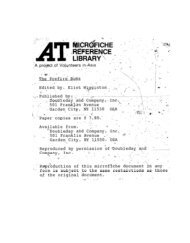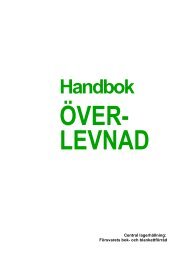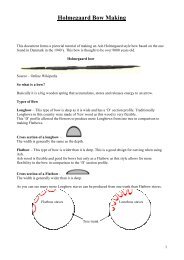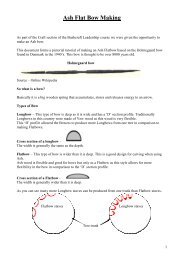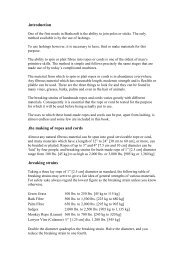Experiments on Knife Sharpening John D. Verhoeven ... - BushcraftUK
Experiments on Knife Sharpening John D. Verhoeven ... - BushcraftUK
Experiments on Knife Sharpening John D. Verhoeven ... - BushcraftUK
Create successful ePaper yourself
Turn your PDF publications into a flip-book with our unique Google optimized e-Paper software.
Japanese waterst<strong>on</strong>es plus leather stropping Roughly 10 blades each weresharpened <strong>on</strong> 6000 and 8000 grit waterst<strong>on</strong>es. Half of each of these experiments wered<strong>on</strong>e <strong>on</strong> blades prepared <strong>on</strong> the Tru H<strong>on</strong>e 600 grit wheels and half <strong>on</strong> 1000 grit wheels.Unless otherwise stated the procedure used involved 10 of the 4-stroke cycles describedabove. It was found that this number of strokes ground the edges back from the positi<strong>on</strong>of the original as-ground edge sufficiently that all remnants of the original burred edgeswere g<strong>on</strong>e. C<strong>on</strong>sequently, the results obtained from the waterst<strong>on</strong>es were independent ofthe starting grind, either 600 or 1000 grit. Initial experiments utilized both 10 and 4 ofthe 4-stoke cycles. It was found that the 4 cycle treatment was not adequate to be certainthat all remnants of the as-ground edge had been removed.The purpose of these experiments was to characterized the nature of the edgesproduced with the waterst<strong>on</strong>es and then to examine the effects of leather stropping up<strong>on</strong>the edge quality. It was the opini<strong>on</strong> of the author at the start of these experiments thatclean leather strops would c<strong>on</strong>tain sufficient levels of natural abrasives adequate toproduce significant improvements in the edge quality. Therefore experiments were d<strong>on</strong>einitially <strong>on</strong> clean leather strops. This was followed by experiments d<strong>on</strong>e <strong>on</strong> leather stropscoated with a thin layer of h<strong>on</strong>ing compound. The compound used here is called MicroFine H<strong>on</strong>ing Compound supplied in the form of a wax impregnated bar having a deepgreen color. The abrasive c<strong>on</strong>tained in the wax bar is a 0.5 micr<strong>on</strong> size chromium oxide.Unless other wise stated this was the h<strong>on</strong>ing compound used <strong>on</strong> the subsequentexperiments described here. Most of the experiments were d<strong>on</strong>e <strong>on</strong> a commercial leatherstrop, a Butz Strop, that was supplied attached to a wooden board. However, initialexperiments were d<strong>on</strong>e with sheets of clean leather purchased from a shoe repair storeand glued to a wooden board. Similar results were obtained using both the hard and softfaces of the leather as well as with the Butz strop.Figure 23 presents SEM images of a 1000 grit c<strong>on</strong>trol blade that had beensharpened <strong>on</strong> the 6000 grit waterst<strong>on</strong>e. The sharpening process utilized 10 of the 4-stroke cycles with <strong>on</strong>ly a very light downward pressure and the directi<strong>on</strong> of moti<strong>on</strong> of theblade <strong>on</strong> the st<strong>on</strong>e surface was into the edge. The two face views at 800x magnificati<strong>on</strong>show that the sharpening process has removed metal from a uniformly thin regi<strong>on</strong> al<strong>on</strong>g19



